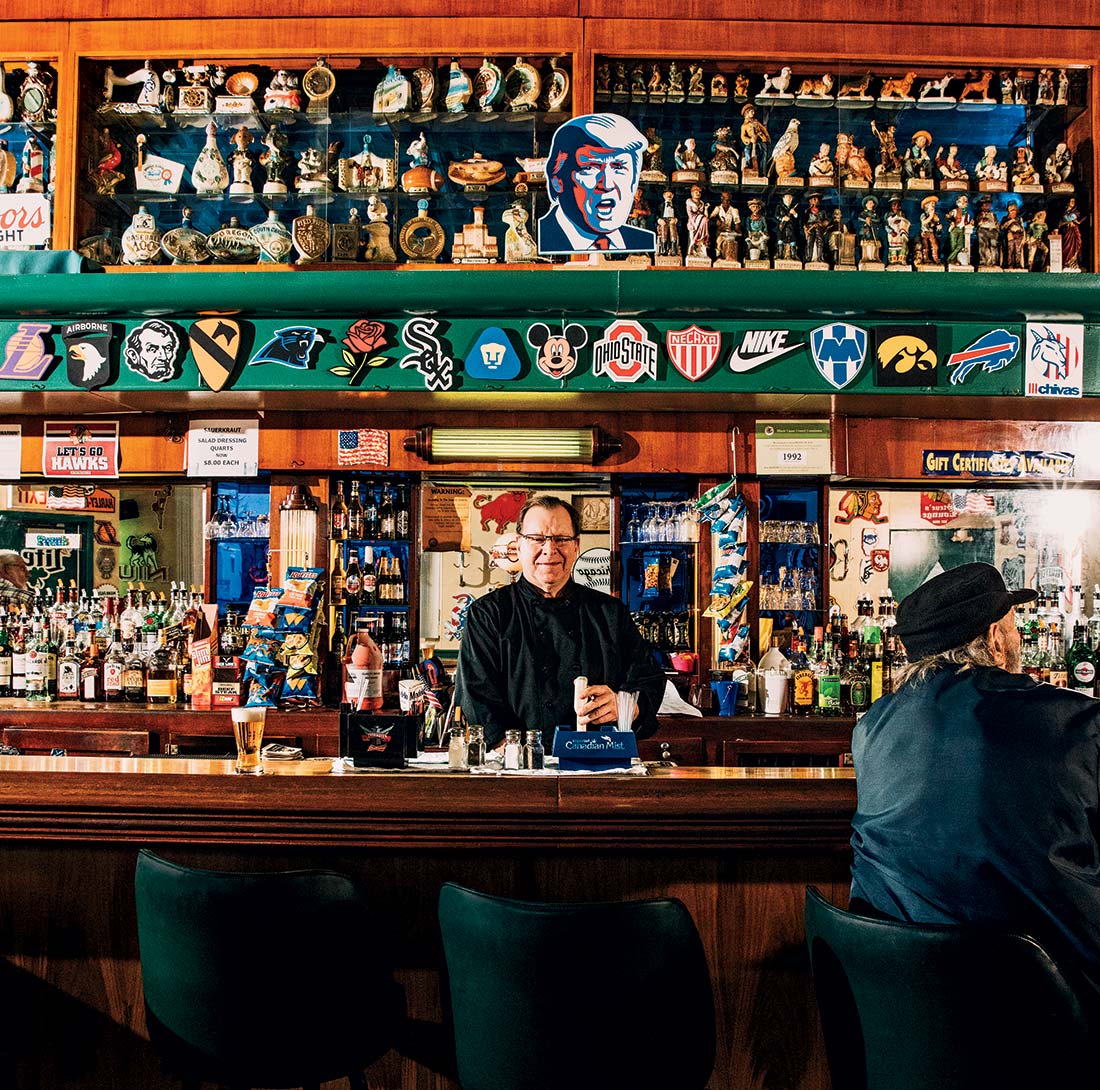Every Saturday at 1p.m., ex-cops, a hardware store owner, an attorney, a newspaperwoman and a Korean War veteran gather in the back room of George L. Tamvakis’s law office — an anonymous storefront with only the words “LAW OFFICE” painted on a window — to solve “the problems of the world.” Or at least the problems of that very small part of the world known as Hegewisch.
The wood-paneled walls are covered with a Miller High Life clock and giant framed photos of the Cubs, the Bears, and the Blackhawks. A refrigerator in the corner dispenses lunchtime beers. There are ashtrays on the conference table, because sometimes this turns into a smoke-filled room. When a youth baseball team needed $800 to make a trip to a tournament Downstate, the money was raised here. So was the money to buy weightlifting equipment for George Washington High School.
“Why not?” Mike Aniol told me last Saturday. He’s the owner of Aniol True Value Hardware, on Baltimore Avenue, which has been in his family since 1955. “It’s your neighborhood! You’ve got to help out. It’s more than a neighborhood. It’s a community. You know your neighbors. You know da people.”
Then Aniol pointed at the refrigerator.
“You want a beer?” he asked. “We got Heineken and Miller Lite.”
Hegewisch, which lies in the southeastern corner of the city, alongside Wolf Lake and the Indiana state line, is Chicago’s most remote neighborhood. Although when I walked its streets — past the storefronts built in the days of Roosevelt and Taft, past the old movie theater, still labeled “THE HEGEWISCH” in tiled lettering, past Supermercado El Tapatio selling hominy for $3.99 a gallon — it felt less like a neighborhood than a self-contained small town on the prairie, miles from the next town over. In fact, they don’t say “in the neighborhood” here. They say “in town.”
“It’s your neighborhood! You’ve got to help out. It’s more than a neighborhood. It’s a community. You know your neighbors. You know da people.”
“When I was a kid,” Aniol said, “you’d get up in the morning, ‘Where am I going fishing or hunting?’ You’d take your shotgun. There’s more nature here than you know. Hegewisch probably has 100 deer. They’re probably going to have to start thinning the herd.”
(Hegewisch has its own state park, the William W. Powers State Recreation Area, alongside Wolf Lake.)
“Fox, possums and raccoons,” said Rose Zivat, co-founder, president and writer for The Hegewisch Times, whose current front page story is about an honorary street designation for the late Kenneth J. Miotk, a “Hegewisch Legend.”
“Turtles trying to cross Avenue O,” put in Edward Jarmuzka, who was wearing a baseball cap from the Hegewisch Veterans South Shore Post of the American Legion.
Hegewisch is so country it has the city’s only sawmill (Calumet Harbor Lumber Company, since 1922), and its only trailer park. I got a ride out to Harbor Point Estates from Bob Wisz, president of the Hegewisch Business Association. I met Bob when he ran for 10th Ward alderman in 1999. He made the runoff, but lost to John Pope. Hegewisch has 9,000 residents, so the Hegewisch vote wasn’t enough to overcome the Daley Machine vote from the East Side, which was organized by the now-defunct Hispanic Democratic Organization.
On our ride out to the trailer park, Wisz had to brake for two deer running across Boy Scout Road, which is what the locals call 134th Street. As a former politician, Wisz has strong opinions about civic affairs. He showed me a horse ring embedded in the sidewalk outside the Old Time Tap on Brandon Avenue to demonstrate that the concrete hasn’t been replaced since the days when the milkman made deliveries in a horse-drawn wagon.
“What that tells you is we’re kind of a forgotten neighborhood for infrastructure,” he said. “We’ve been written off as an industrial area. Residential and commercial won’t exist because it’s so close to Indiana.”
Related Content
Hegewisch’s best-known visit from a Chicago mayor occurred on December 20, 1976, when Richard J. Daley sank a free throw at the dedication of a new gymnasium and field house at Mann Park. It was Daley’s last official act as mayor. A few hours later, he died of a heart attack. The last time anyone remembers seeing a mayor in Hegewisch is 20 years ago, when Daley’s son dedicated a streetscape on Baltimore Avenue.
When I asked Aniol whether he feels that Hegewisch is part of Chicago, he responded “Nooo. God no. Except when it’s time for the inspectors and the tax people. I don’t feel we have our fair share of city services and we have to compete with Indiana.”
Then he gazed down at the Winstons on the table in front of him.
“Of course, you can live in Chicago and go to Indiana to buy your cigarettes for fi’ dollars.”
Hegewisch’s sense of being on its own, down there at the city limits, is the source of much of the neighborhood’s pride. Local boy Rick Kubic often tells Hegewisch tales on WJOB-AM, a 1,000- watt radio station out of Hammond, pushing a button to produce a musical “HEG-wisch!,” which sounds like Svengoolie’s “Berwyn.”
Jason Highland grew up in Hegewisch, lives four houses from his parents on Carondelet Avenue, works as dean of students at George Washington High School, and last year bought the Old Time Tap, the southernmost tavern in Chicago. It looks like a dive from the outside, with no windows and uneven white wooden lettering on the red brick. Inside, though, the pressed tin ceiling of the 1906 building still remains.
“I hardly ever go downtown,” said Highland, who can work, shop, and drink in Hegewisch. “The only thing we don’t have is a gas station, and we’re never going to have that with how cheap the gas in Indiana is.”
Then, Highland summed up Hegewisch’s position in the city: “Everything north of 95th Street is the North Side,” he said.



